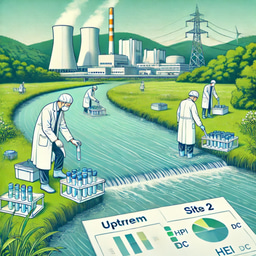Key factors in the formation of the main ions composition for power plant cooling water system: a case study of technological and environmental aspects
Published in Earth & Environment

In the age of sustainable development, balancing industrial progress with environmental protection is no longer a choice - it is a necessity. One of the critical areas of concern is the influence of energy generation on our water ecosystems. A recent study from Ukraine sheds new light on this delicate balance by exploring how the Nuclear Power Plant (NPP) interacts with the Styr River, a vital watercourse and ecosystem.
Cooling water systems are essential for nuclear power plants, as they regulate reactor temperatures and prevent overheating. However, these systems also transform the very water they use. Over time, the water accumulates a variety of dissolved substances known as "main ions," including bicarbonates, carbonates, sulfates, chlorides, calcium, magnesium, sodium, and potassium. These ions are not inherently harmful, but their increasing concentrations can disrupt natural water chemistry when discharged back into rivers.
The researchers from the National University of Water and Environmental Engineering: Olha Biedunkova and Pavlo Kuznietsov, set out to meticulously examine how NPP’s water management practices affect the composition of the Styr River. They constructed a detailed portrait of the water’s journey through the plant and back into nature through a blend of field sampling, advanced chemical analysis, and statistical modeling.
One of the study’s standout achievements lies in its methodical tracking of ion concentration changes at multiple points: before water enters the plant, within the plant's cooling cycle, and after its return to the river. This holistic approach revealed fascinating dynamics. For instance, certain ions, like sulfate and calcium, see significant increases in concentration due to the treatment processes applied to prevent scale formation inside the cooling system. Sulfuric acid, in particular, is used extensively to balance water chemistry, but as a consequence, it elevates sulfate levels in the returned water.
Surprisingly, despite these chemical changes, the environmental impact remains relatively modest. The increase in ion concentrations in the river water post-discharge is around just 2%, a testament to the plant’s controlled operations and natural dilution capacity. Notably, the researchers emphasized that the Styr River maintains a “good” ecological status, even after the plant's effluents discharge.
What makes this study especially innovative is its use of predictive modeling. By employing Pearson’s correlation and regression analysis, the team could accurately forecast ion concentrations in the river based on the plant’s operational data. This predictive capacity is invaluable. It allows plant operators and environmental authorities to anticipate and manage ecological impacts proactively, rather than reacting to environmental damage after it occurs.
The research also pioneers the application of the "grey water footprint" (GWF) method in this context. The GWF quantifies the volume of water needed to dilute pollutants to acceptable levels, offering a practical measure of environmental burden. For the NPP, the GWF calculations revealed that the river's natural flow is more than sufficient to assimilate the discharged ions without compromising water quality. This finding not only underscores the responsible management of water at the NPP but also highlights GWF as a valuable tool for assessing industrial water use impacts globally.
Furthermore, the study delves into the seasonal variations of certain ions, like bicarbonates and carbonates, which fluctuate naturally with changes in temperature and biological activity. Understanding these patterns is crucial, as it helps distinguish between natural environmental processes and human-induced changes.
Beyond its immediate findings, the study offers a broader message for sustainable industrial practice. It underscores the importance of continuous monitoring and integrated water management strategies. Nuclear power, often scrutinized for its environmental risks, is shown here to be capable of operating within safe ecological margins when diligent management is applied.
By combining rigorous scientific methods with forward-looking management tools, the NPP example illustrates that modern energy production and environmental stewardship can coexist.
In conclusion, this study is more than just an analysis of water chemistry—it is a blueprint for responsible environmental governance in the energy sector. Through predictive models, precise water quality monitoring, and innovative metrics like the grey water footprint, we are better equipped to ensure that rivers like the Styr River continue to thrive alongside human progress.
As energy demands grow worldwide, studies like this remind us that sustainable solutions are within our reach, provided we commit to understanding and respecting the natural systems that support us.

Please sign in or register for FREE
If you are a registered user on Research Communities by Springer Nature, please sign in
I am deeply disappointed with the handling of my manuscript by Discover Applied Sciences (Springer). Although Springer promises a full APC waiver for authors from Ukraine, I received repeated payment reminders and was left in prolonged uncertainty without any clear resolution. The entire editorial process took nearly 8 months, including months of delay for even minor revisions. Due to this unprofessional handling and lack of timely communication, I was ultimately forced to withdraw my manuscript. I strongly advise future authors to be cautious when considering submission to this journal.